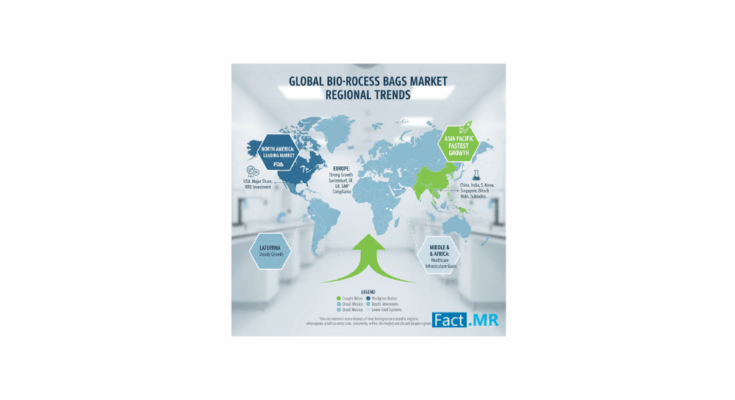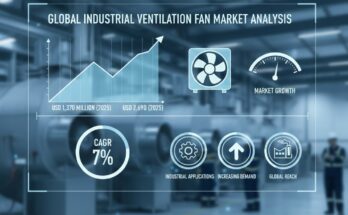The global bioprocess bags market is on a transformative growth trajectory, projected to rise from USD 4.3 billion in 2025 to USD 20.5 billion by 2035, registering a remarkable CAGR of 16.9%. This surge is being fueled by the increasing adoption of single-use technologies in biopharmaceutical manufacturing, the rising production of biologics, and the industry-wide shift toward flexible, modular facilities.
Single-use bioprocess bags have emerged as a cornerstone of modern biomanufacturing, providing scalable, contamination-free solutions for upstream and downstream operations. The growing prevalence of biologics, cell and gene therapies, and personalized medicines has significantly accelerated the need for these flexible systems. Unlike traditional stainless-steel infrastructure, bioprocess bags offer reduced cleaning validation, lower capital investment, and enhanced operational agility, aligning with the evolving needs of contract development and manufacturing organizations (CDMOs) and large biopharma companies.
Bioprocess Bags Market Drivers of Market Growth
The surge in biologics manufacturing is the primary growth driver for bioprocess bags. Monoclonal antibodies, vaccines, and advanced therapies require sterile, closed systems to ensure consistent quality and safety. Additionally, post-pandemic investments in localized biomanufacturing facilities, particularly in Asia Pacific and Latin America, have expanded the adoption of single-use solutions in emerging markets.
Cost efficiency, operational flexibility, and regulatory acceptance by agencies such as the FDA and EMA are further encouraging adoption. Industry leaders like Sartorius AG, Thermo Fisher Scientific, and Danaher are investing in recyclable and environmentally responsible materials, reflecting a broader commitment to sustainability without compromising performance.
Bioprocess Bags Market Regional Market Dynamics
North America continues to lead the global market, supported by a robust biopharmaceutical ecosystem, advanced manufacturing infrastructure, and widespread adoption of single-use platforms. The U.S. bioprocess bags market is strengthened by consistent biologics R&D, a high concentration of CDMOs, and regulatory frameworks that facilitate single-use compliance.
Europe remains a key market with Germany, Switzerland, and the U.K. driving adoption. Regulatory compliance, automation, and sustainable production practices have accelerated the shift to disposable systems across manufacturing facilities. EU-backed initiatives for biologics, vaccines, and gene therapies further contribute to market expansion.
The Asia Pacific region represents the fastest-growing market, with China, India, South Korea, and Singapore leading the charge. Government-backed programs such as China’s “Made in China 2025” and India’s “Pharma Vision 2020” have enhanced domestic biomanufacturing capabilities, promoting cost-effective, scalable systems like bioprocess bags. CDMO expansion, rising clinical trials, and supportive regulatory reforms are accelerating adoption in this dynamic region.
Emerging markets in Latin America and the Middle East & Africa are also witnessing growth, with countries like Brazil, Mexico, Saudi Arabia, and the UAE investing in local pharmaceutical manufacturing. Flexible, low-cost, and contamination-free bioprocess systems are increasingly sought after to reduce import dependency and support regional biotech growth.
Bioprocess Bags Market Challenges and Market Restraints
Despite the robust growth trajectory, challenges persist. Material shortages, supply chain disruptions, and cost volatility remain concerns due to reliance on specialty polymers. Environmental scrutiny over single-use plastics is intensifying, particularly in regions with stringent sustainability targets.
Technical risks, such as leachables and extractables, require rigorous validation, increasing regulatory and quality assurance burdens. High upfront qualification costs, integration issues with legacy systems, and varying global regulatory standards add complexity to market adoption. Manufacturers must continually invest in R&D and compliance to maintain competitive advantage.
Bioprocess Bags Market Product and Application Insights
Three-dimensional (3D) bioprocess bags are gaining market dominance due to their superior operational efficiency and adaptability for large-scale upstream fermentation and downstream purification. Large-capacity bags are becoming essential in commercial-scale operations for buffer and media storage, cell culture, and downstream processes, integrating seamlessly with single-use bioreactors and automated systems.
Buffer and media storage remains the largest application segment, reflecting the demand for sterile, closed systems that reduce contamination risk and simplify handling. Pharmaceuticals are the primary end-users, with bioprocess bags playing a critical role in biologics, vaccines, and biosimilars manufacturing.
Alcohol-based and synthetic materials continue to dominate bag compositions, ensuring stability, regulatory compliance, and broad compatibility with both upstream and downstream processes. Continuous innovation in material science, bag design, and sensor integration is enhancing the performance, traceability, and process control of modern bioprocessing platforms.
Bioprocess Bags Market Competitive Landscape and Recent Developments
The market is highly competitive, with leading players such as Corning Incorporated, Charter Medical Ltd., Danaher Corporation, Entegris Inc., Merck, Rim Bio Inc., Saint-Gobain, Sartorius AG, and Thermo Fisher Scientific driving innovation. Strategic partnerships, capacity expansion, and targeted acquisitions are shaping the competitive environment.
Notably, in 2023, Sartorius Stedim Biotech completed a €2.4 billion acquisition of Polyplus, securing capabilities in viral vectors and transfection reagents crucial for cell and gene therapy manufacturing. Such strategic moves underscore the industry’s commitment to delivering scalable, high-performance, and sustainable bioprocessing solutions.
Bioprocess Bags Market Outlook
The global bioprocess bags market is set for sustained growth over the next decade, driven by increased biologics production, CDMO expansion, and the shift toward flexible, modular facilities. Technological innovation, material sustainability, and regulatory compliance will continue to guide market dynamics, while emerging markets offer significant expansion opportunities.
Industry leaders investing in R&D, automation, and environmentally conscious materials are poised to capture substantial market share, solidifying the role of bioprocess bags as essential enablers of modern biopharmaceutical manufacturing.
Browse Full Report : https://www.factmr.com/report/3926/bioprocess-bags-market



